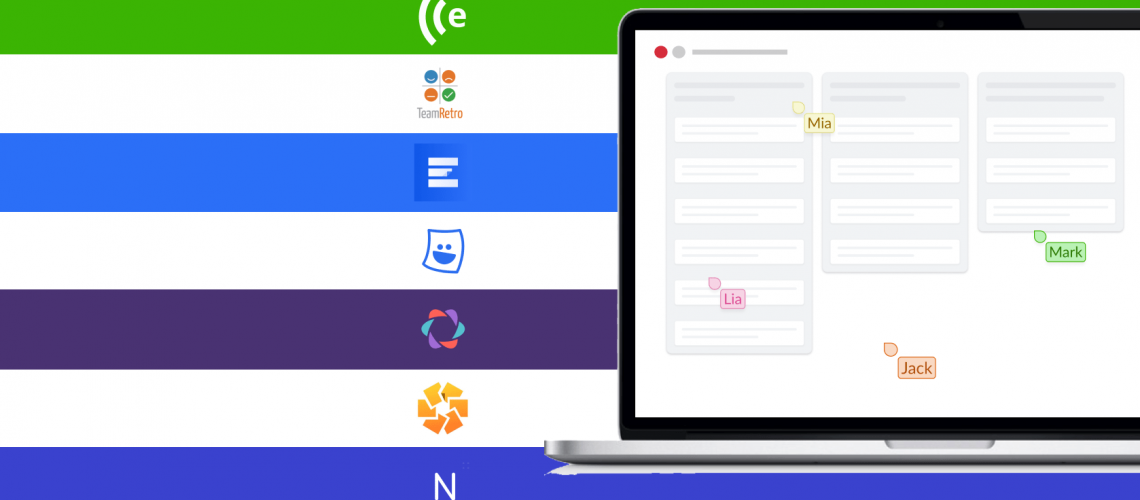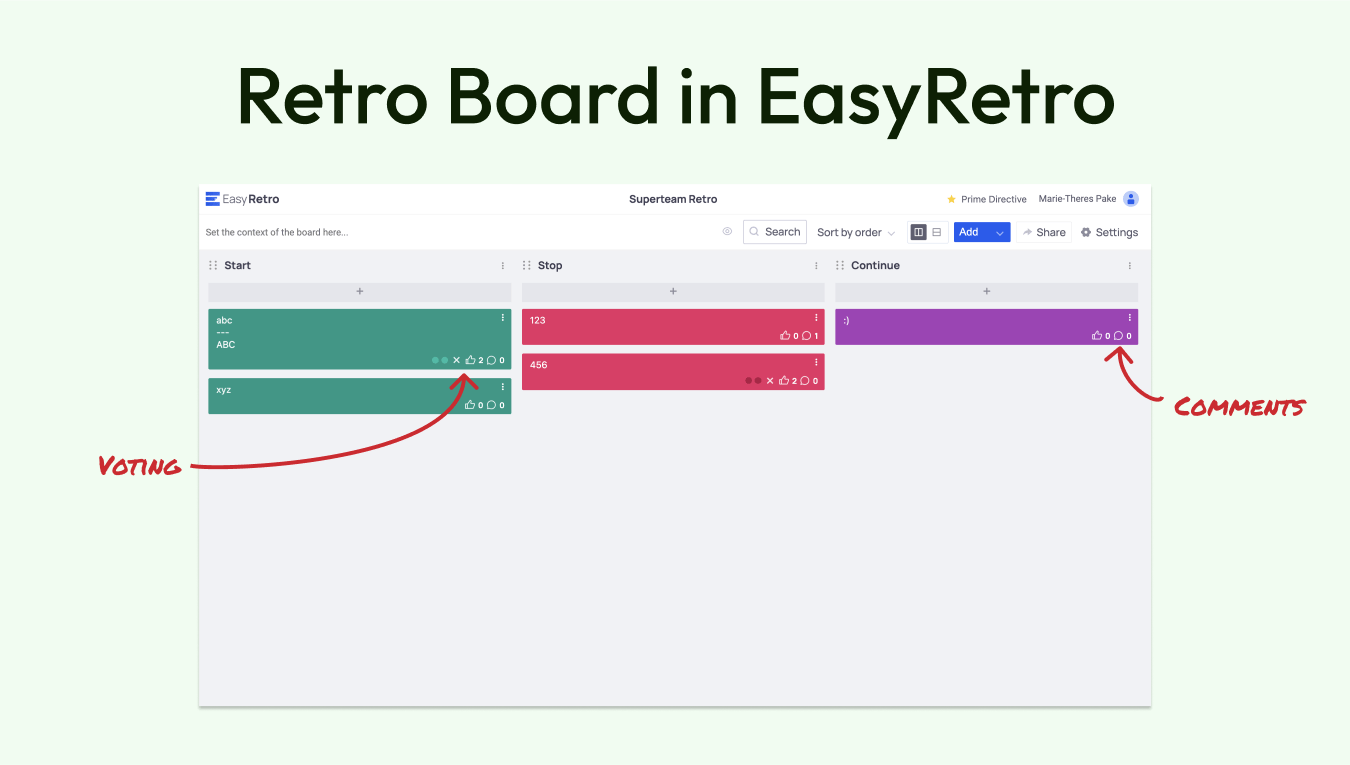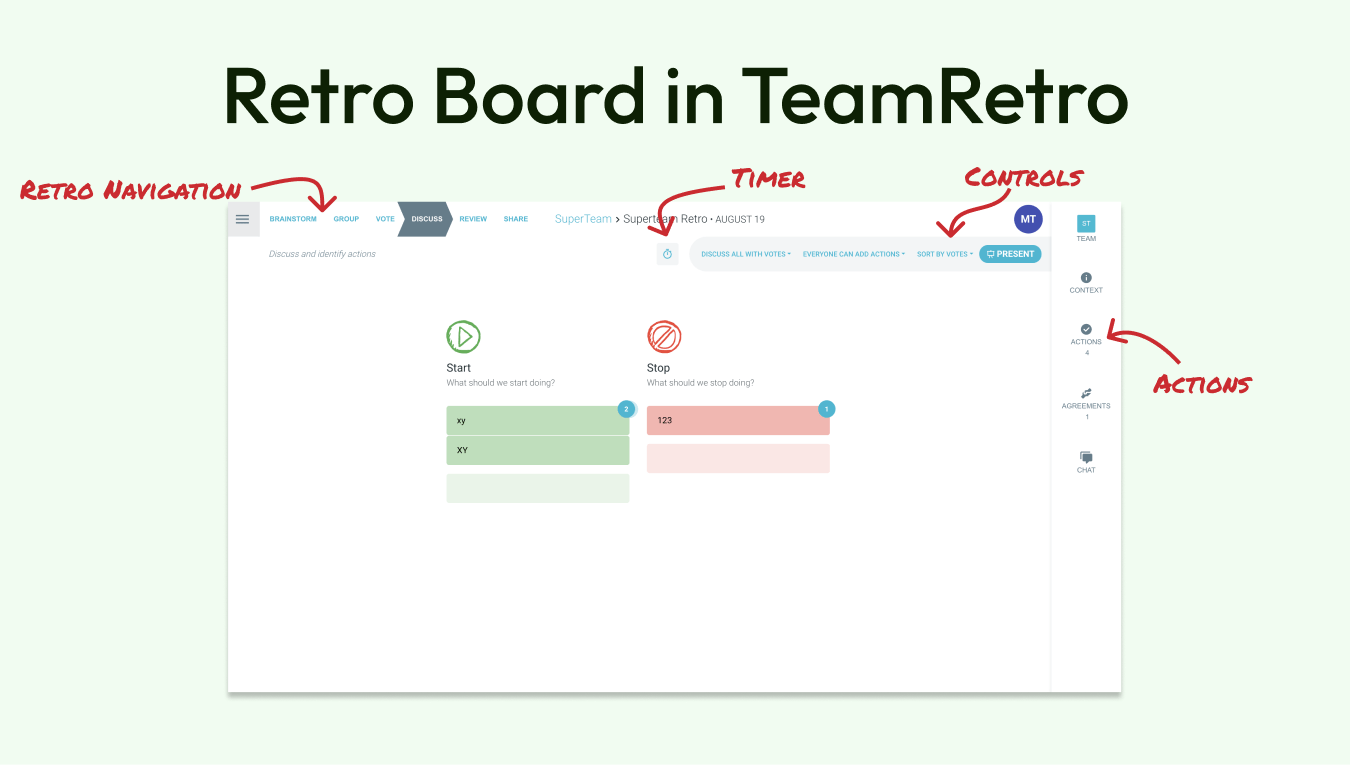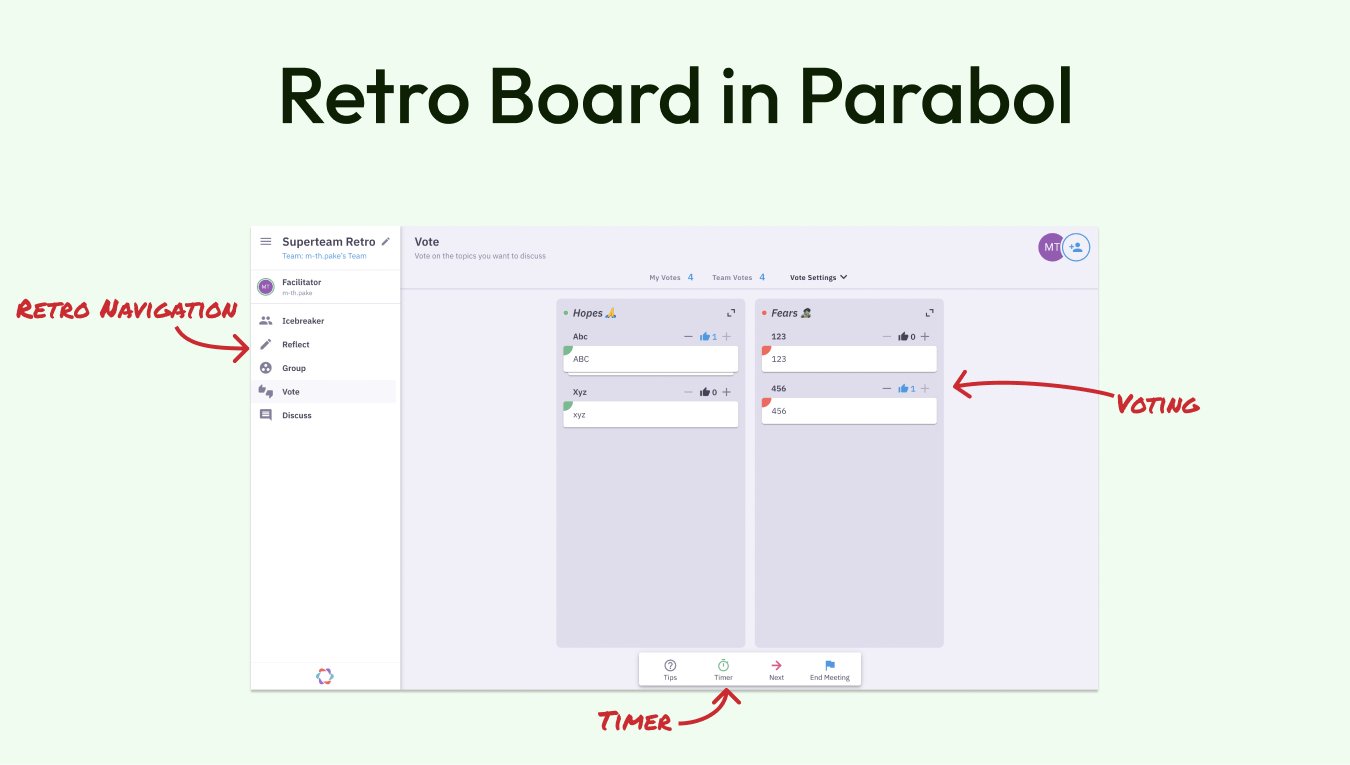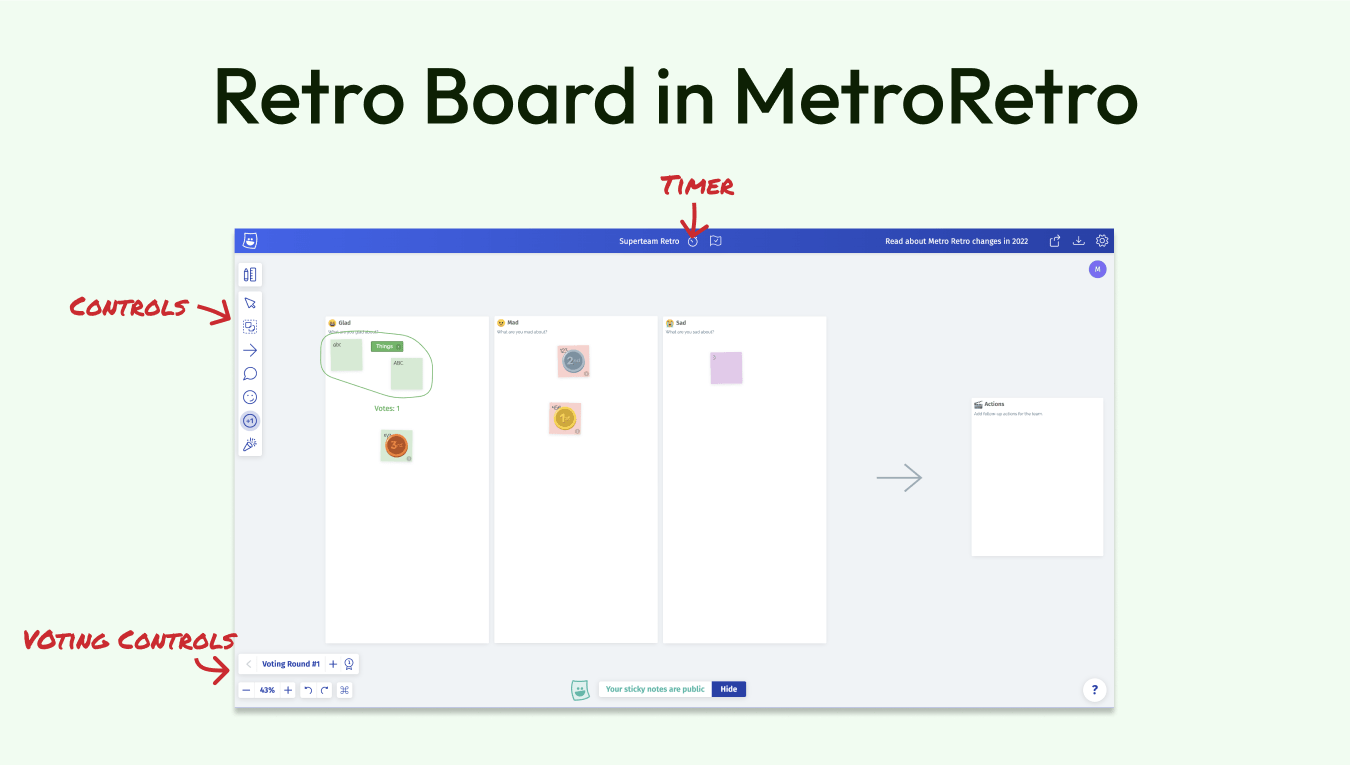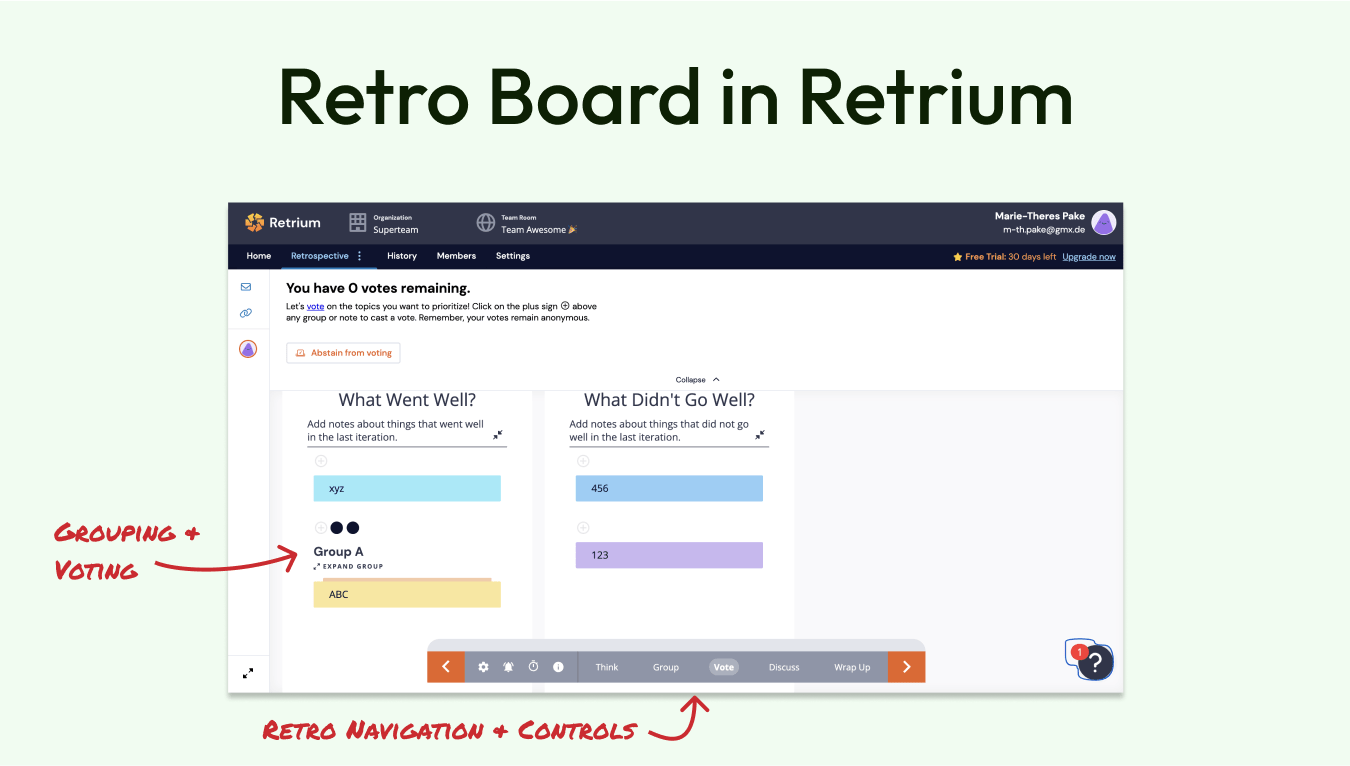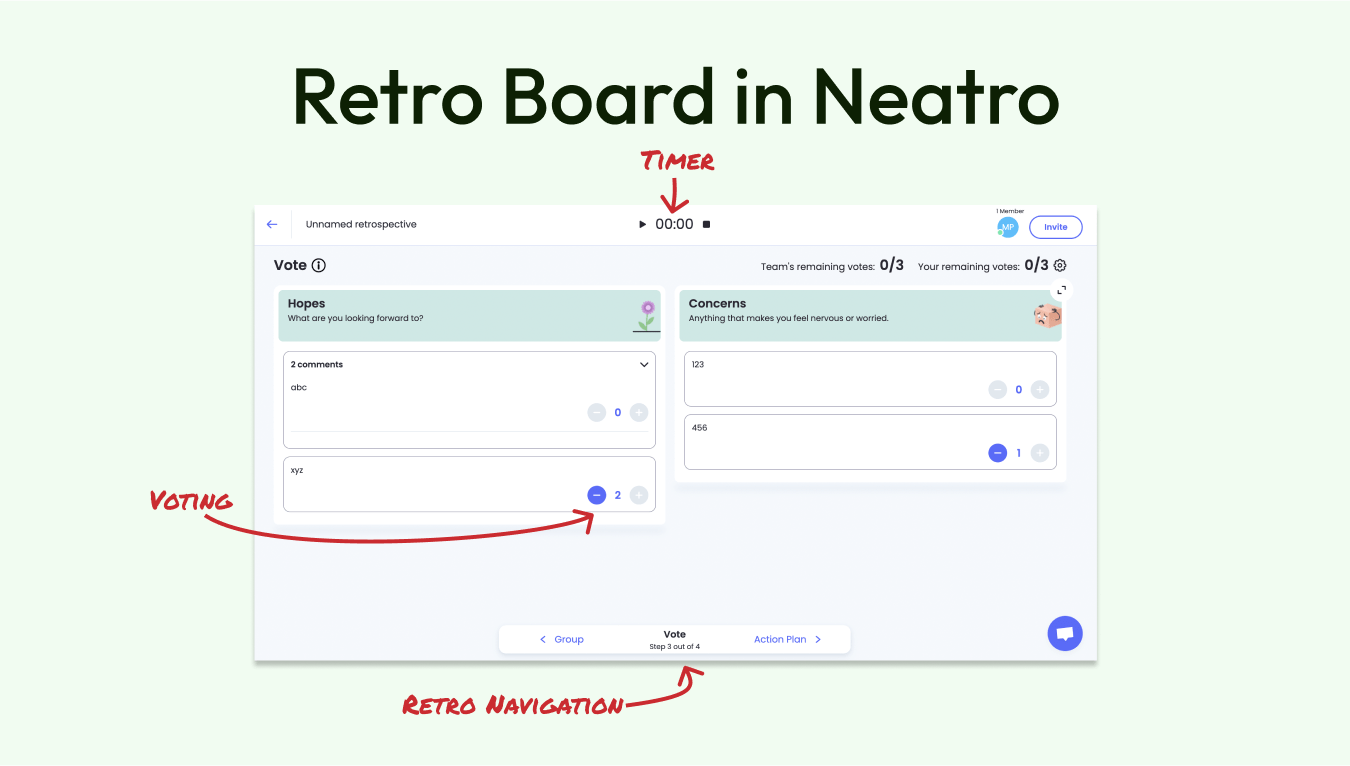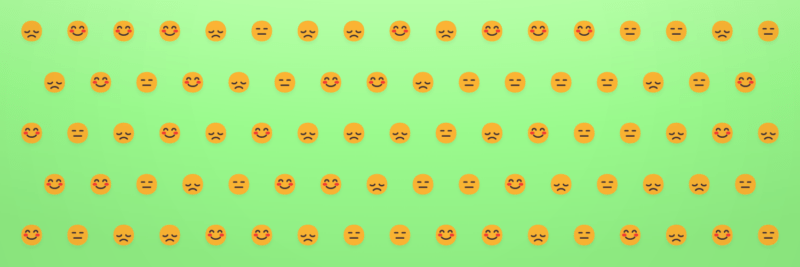Free Retro boards, online whiteboards or maybe even project management tools like Jira: There are many ways to facilitate digital retrospectives online.
In this article I will show you every single best free sprint retrospective board there is - and what advantages the online retro boards offer.
We will compare the 7 best retro boards and even look at some less known solutions like for example the Reetro board - giving you all the information you need.
60+ Fun Retro Methods
For the impatient among you: The retro board from the tool Echometer includes more than 60 interactive, fun and free retrospective ideas.
If that sounds interesting, feel free to explore them right now without registering:
Sailboat Retro
Example: Let's imagine we are a sailboat. Tailwind: What drives us forward?
Mario Kart Retro
Example: Which bananas did we slip on?
Good vs. Bad Retro
Example: What are 3 recent things that went particularly well?
Discover More Retro Ideas
For all others, below you will find a comparison of the 7 best retro board tools. We always take into account or compare certain criteria – more you can also find behind the respective toggles in the presentation of the respective Kanban Retro Board Tool (More on: Retrospective Kanban Board).
Before we go into the different retro software individually, here is a short overview of the retro boards.
| Evaluation criteria | Echometer | Retrium Board | Team Retro | FunRetro former EasyRetro Board | Parabol Board | MetroRetro Board |
|---|---|---|---|---|---|---|
| Interactive online retrospectives |  Yes Yes |  Yes Yes |  Yes Yes |  Yes Yes |  Yes Yes |  Yes Yes |
| Automatically generated retro summaries |  Yes Yes |  Yes Yes |  Yes Yes |  Yes Yes |  Yes Yes |  Yes Yes |
| Supported facilitation (Check-In Generator etc.) |  Yes Yes |  Yes Yes |  Partially Partially |  No No |  Partially Partially |  Partially Partially |
| Templates for every level of team maturity |  Yes Yes |  Partially Partially |  Partially Partially |  No No |  No No |  No No |
| Continuous tracking of action items (retro to retro) |  Yes Yes |  Partially Partially |  Partially Partially |  No No |  Yes Yes |  No No |
| Team development measured over time |  Yes Yes |  Partially Partially |  Yes Yes |  No No |  No No |  No No |
| Collecting feedback before retros (optional) |  Yes Yes |  No No |  No No |  No No |  Yes Yes |  No No |
| Organizational Health Checks |  Yes Yes |  No No |  No No |  No No |  No No |  No No |
| Health Check Item Pool with nudges (food for thought) |  Yes Yes |  No No |  No No |  No No |  No No |  No No |
| Mobile Device Support for on-site retros |  Yes Yes |  No No |  No No |  No No |  No No |  No No |
| Integrated Online-Whiteboard |  Yes Yes |  No No |  No No |  No No |  No No |  Yes Yes |
| Data protection (developed and hosted in Europe) |  Yes Yes |  No No |  No No |  No No |  No No |  No No |
| Free version (after trial) |  Yes Yes |  No No |  No No |  Yes Yes |  Yes Yes |  Yes Yes |
Sprint Retro board free: Comparing the 7 best retro boards
#1. | Fun Retrospective Boards Online
Echometer
Echometer Screenshot
Retro board online features in Echometer | |
|---|---|
| Start without login & registration |  |
| Assisted retro facilitation |  |
| (Optional) Anonymity |  |
| Grouping & Linking |  |
| Voting |  |
| Timer for timeboxing |  |
| Flexibility (optional whiteboards) |  |
| Tracking of actions items |  |
| Measuring the quality of a retro (ROTI) |  |
| Automated Retro Summaries |  |
Details on Echometer Retrospective Board
Timer: The individual phases of the retro are easy to understand in Echometer (navigation bar at the top). Each step starts with (optional) short instructions that support inexperienced Agile Coaches, Scrum Masters, Product Owners and other facilitators. A timer can also be found, making time management super easy. Nice to have: The timer even triggers a hint if you spend too much time in one retro step.
Structure: Echometer is a free retro board without login - so you can start pretty easily. The free retro board appears in Echometer after the check-in in the "Collect data" phase. In this phase, team members can enter their feedbacks. Optionally, they can also give asynchronous feedback via a survey upfront. Similar feedback can be grouped across different retro board columns or questions. All the feedbacks/answers are happing on an anonymous retro board, but you can highlight your own answers.
Flexibility & Voting: In the "Analysis and Action item" step, further columns and feedback can be added flexibly. The grouping feature is still available until voting starts. Facilitators can choose how many votes team members should get. I like that Echometer offers a suggestion for the number of votes, depending on how many participants vs. feedbacks there are in the retro. After the voting, the prioritized topics are automatically sorted: topics with many votes are highlighted at the top, topics without votes are hidden.
Action items: In this sprint retrospective app, action items can easily be created via an "Add Action item" button. As another option, Echometer offers to link the action items directly with specific feedback. These kinds of links even work between feedbacks and a whiteboard. Feedback cards can be copied directly onto a whiteboard. Echometer offers retrospective whiteboard templates for creating action items, and of course you can create your own whiteboards if you want. If you typically have your retrospective board in Jira, you will love the Jira integration of Echometer, that might be used as Atlassian retrospective board.
Check out: At the end of the retro, the ROTI is automatically queried. This can later be called up in the retro summaries, together with the complete retro board, the action items created and the whiteboards. Action items can be stored in Jira boards via the Jira integration.
Analytics: Echometer positions itself as an agile retrospective board for data-driven Agile Coaches and Scrum Masters. The tool has the most fancy analytics retrospective dashboard: After and within the retro, there are various ways to make the maturity of the team measurable via team health checks in the retrospective dashboard. You can find more about this on the Echometer website.
In summary, Echometer is an excellent free retro board. You can definitely call it a simple or easy retro board (in terms of operation & UX), and a fun retro board as well - feel free to try it out.
As discussed, one of the nice things about the Echometer sprint retrospective board is that it is a free retro board without login. You can directly open our retro templates below.
You can even simply browse through our library of retrospective formats (see "Discover more") – have fun:

#2. | Fun Retrospective Boards Online
FunRetro former EasyRetro Board
FunRetro former EasyRetro Screenshot
Features of the Easy Retro Board (former FunRetro) | |
|---|---|
| Start without login & registration |  |
| Assisted retro facilitation |  |
| (Optional) Anonymity |  |
| Grouping & Linking |  |
| Voting |  |
| Timer for timeboxing |  |
| Flexibility (optional whiteboards) |  |
| Tracking of actions items |  |
| Measuring the quality of a retro (ROTI) |  |
| Automated Retro Summaries |  |
Details on Easy Retro Board (former Fun Retro Board)
Structure: At Easyretro the complete retro takes place on one board. There is therefore no separate check-in, check-out or similar. This can be configured beforehand using templates. Additional columns can be added via the "Add" button if required (More on: Retrospective Board Columns).
Survey: In the free version, one survey can be linked to one retro board at a time. A survey is a question with answer options to tick. Unfortunately, these surveys cannot be sent out in advance of the retrospective (as is the case with Echometer), but can only be created and answered during the retrospective. In the paid version, multiple questions can also be added (More on: Software Retrospective Questions). The team's feedback is anonymous, and their own response can be highlighted here as well.
Grouping & Voting: During the retro, the individual feedback cards can be moved and grouped between the columns on the fun retro board. The "Facilitation Controls" allow you to manually set the show/hide of feedback cards, voting and various other options. Voting can be done at any time both on groups and on individual feedback cards. Since Easyretro does not specify a process for the structure of a retro, the collection of feedback, the coordination and the creation of action items can take place at the same time. So be careful with the Easy Retro board settings, as this flexibility in the settings can lead to an unstructured retro, especially for users with little experience.
Invitation of colleagues: The "Sharing" button can be used to scan a QR code as well as copy a link that allows third parties without EasyRetro accounts to participate in the agile retrospective board (More on: Agile Retrospective Board).
Retro summary: After the retro, the fun retro board used can still be called up, and the action items can be viewed on an extra page. For those of you who have their sprint retrospective board in Jira: Thanks to integrations with Jira, Confluence and Slack, action items can also be exported, similar like in the action tracker of the Reetro board.
In summary, it's not a bad free retro board. You can call it an easy retro board (just because of the name, I guess) and a fun retro board (again, because of their former name), similar to the other retro boards.
#3. | Fun Retrospective Boards Online
Retro board free: TeamRetro
Team retro Screenshot (fun retro free board)
Sprint Retro board online features in TeamRetro | |
|---|---|
| Start without login & registration |  |
| Assisted retro facilitation |  |
| (Optional) Anonymity |  |
| Grouping & Linking |  |
| Voting |  |
| Timer for timeboxing |  |
| Flexibility (optional whiteboards) |  |
| Tracking of actions items |  |
| Measuring the quality of a retro (ROTI) |  |
| Automated Retro Summaries |  |
Details on the TeamRetro Retrospective Board
Structure: Teamretro is a retro board with predefined phases. Here, too, feedback is not collected in advance via surveys, but online during the retro on the Scrum Retrospective Board (More on: Scrum Retrospective Board Online Free). The interesting thing is that this brainstorming happens in two steps: In the first step, the retro participants can brainstorm privately before the answers are shared publicly. In the case of shared answers, the moderator can determine before the start of the retro whether the answers should be displayed anonymously, with alias or name.
Templates: As with Echometer and Easyretro, there is the option of either selecting a template for the retro or designing it freely. After writing down their answers, participants also have the option of grouping answers across columns in the TeamRetro fun retrospective app.
Navigation: A navigation bar makes it easy to switch from one step to the next. There is a voting feature for prioritizing.
Action items: Action items (here "Action Plan") and "Team Agreements" can be created throughout the retrospective via the sidebar.
Check out: At the check-out, the participants can indicate the ROTI on a scale from 1 to 5.
Summary: After completing the retro, actions items will be displayed on the home screen. The online agile retrospective board can also be called up after the end of the retro. However, there is no retro archive with an overview of all the retros.
In summary, Teamretro is a decent free retro board. You can call it a fun retrospective board and an easy retro board (in terms of UX), similar to the other retro boards. And it is even is an Azure DevOps retrospective board and a retro board in jira, as it has an integration to both Azure Devops and Jira.
#4. | Fun Retrospective Boards Online
Parabol Board
Parabol Screenshot (fun retro free board)
Retro board online features in Parabol | |
|---|---|
| Start without login & registration |  |
| Assisted retro facilitation |  |
| (Optional) Anonymity |  |
| Grouping & Linking |  |
| Voting |  |
| Timer for timeboxing |  |
| Flexibility (optional whiteboards) |  |
| Tracking of actions items |  |
| Measuring the quality of a retro (ROTI) |  |
| Automated Retro Summaries |  |
Details on the Parabol Remote Retrospective Board
Structure: With Parabol, too, the feedback is collected on the retro board. After the (private) brainstorming, feedback cards are shared anonymously. Cross-column groups are possible on this Scrum retro board online, as in most other tools like the Reetro board. When voting, the maximum number of possible votes per participant and per topic/card can be set. After the voting, all topics are presented individually for discussion in Parabol. In my opinion, this step should rather take place before the vote or after the vote (only with those topics that have been prioritized) to support good time management. Parabol offers a timer.
Action items: When discussing the feedbacks, an action item can be put down at any time.
Retro summary: After all the steps of the retro have been completed on the board, a summary of the retro is displayed. Unfortunately, Parabol does not offer an official check-out with ROTI, nor does it offer integrated whiteboards. Pretty handy though: It offers an integration to Azure DevOps, so we have another Azure DevOps retrospective board. It also offers their online retro board in Jira, i.e., feedbacks can be imported and exported.
Timeline: After the retro, the results can be called up again via the "Timeline". Since the "Timeline" shows various activities, it is a little harder to find all retros. There is no independent retro archive of all retros.
In summary, Parabol is another decent free retro board. It deserves to be called a fun retro board and simple retro board (in terms of UX).
No 5. | Fun Retrospective Boards Online
Metro Retro
Metro Retro screenshot
Online sprint retrospective board free: features of Metro Retro | |
|---|---|
| Start without login & registration |  |
| Assisted retro facilitation |  |
| (Optional) Anonymity |  |
| Grouping & Linking |  |
| Voting |  |
| Timer for timeboxing |  |
| Flexibility (optional whiteboards) |  |
| Tracking of actions items |  |
| Measuring the quality of a retro (ROTI) |  |
| Automated Retro Summaries |  |
Details on the Metro Retro Retrospective Board
Procedure: MetroRetro is a retro board whose structure, in turn, is strongly based on a classic whiteboard. The preparation is quick: A template can be selected, then the program starts directly. Polls in advance do not take place here either (More on: Software Retrospective Questions). The participants give their feedback directly as anonymous sticky notes on the Retro Board. To organize them, they can first be written face down and then revealed later. In addition, the sticky notes can be grouped together. When voting, the facilitator(s) can determine the number of possible voting points. Prioritized topics are clearly marked.
Structure: During the retro, there is no structure, no clear process set by the board, but here are a few tips. A timer helps with time management.
Action items: There is an area on the Scrum retro board online for creating action items. Like the feedback, action items are created as sticky notes. Unfortunately, there is no integration with Jira or other tools, the action items have to be transferred manually to other tools after the retro.
Retro summary: It is obvious that the "retro follow-up" is not the focus of this retro board. A retro and action items summary is missing. However, retros can still be opened at any time.
Noteworthy: For the fun factor, Metro Retro developed a fun confetti bomb feature. Rather negative: At the moment, Metro Retro does not have any integrations, no possibility to connect with your sprint retrospective board in Jira for example - this is not an Atlassian retrospective board.
Metro Retro is a good free retro board, which is characterized in particular by its flexibility. It's quite a fun retro board, and also an easy retro board (if users have some whiteboard experience).
No. 6. | Fun Retrospective Boards Online
Retrium Board
Retrium Screenshot (Scrum sprint retrospective board online free)
Online sprint retrospective board free: Features of Retrium | |
|---|---|
| Start without login & registration |  |
| Assisted retro facilitation |  |
| (Optional) Anonymity |  |
| Grouping & Linking |  |
| Voting |  |
| Timer for timeboxing |  |
| Flexibility (optional whiteboards) |  |
| Tracking of actions items |  |
| Measuring the quality of a retro (ROTI) |  |
| Automated Retro Summaries |  |
Details on the Retrium Retrospective Board
Templates: Retrium has two different types of retro boards: a board with sticky notes and one with a team radar. Depending on which type of interactive retrospective board is chosen, the templates provided vary. Feedback is anonymous on both boards.
Voting: The anonymous online retro board (agile) comes with features very similar to the retro boards previously described or the Reetro board. A timer supports the team in time management, and the board guides you through the retro step-by-step. The voting feature is a bit more sophisticated here: There is a maximum of 3 votes per participant and there is even the option to abstain.
Structure: As with Parabol, in Retrium all topics are presented individually for discussion after voting. A discussion on an extra whiteboard retrospective is not supported. In the fun retro app of Parabol, Action items can only be created when using a "Sticky-Notes Retro", not in a radar retro.
Check out: When the retro has ended, it is being asked for the ROTI and the results of the retro are summarized in an exportable form. Completed retros can also be found and opened via the "Timeline".
Retro Summary: Unfortunately, there is no separate archive where the retros and the action items are listed.
The "radar retro" differs from the board retro in that the focus here is on closed questions (as opposed to open questions). The live analytics of the radar (e.g. mean value, etc.) are pretty handy. Unfortunately, other features such as voting, creating action items or creating comments are missing in this type of retro.
Retrium is a decent free retro board that can probably be considered one of the most used tools. Much like the other tools, it's a fun retro board and equally easy retro board.
No. 7. | Fun Retrospective Boards Online
Neatro Board
Neatro Screenshot (Scrum sprint retrospective board online free)
Online retrospective board free: features of Neatro | |
|---|---|
| Start without login & registration |  |
| Assisted retro facilitation |  |
| (Optional) Anonymity |  |
| Grouping & Linking |  |
| Voting |  |
| Timer for timeboxing |  |
| Flexibility (optional whiteboards) |  |
| Tracking of actions items |  |
| Measuring the quality of a retro (ROTI) |  |
| Automated Retro Summaries |  |
Details on the Neatro Retrospective Board
Preparation: Neatro's Retro Board can be planned in advance with templates and shared with the team by schedule. Here, too, the retro takes place on the board in column format. In the first step, participants can brainstorm on hidden sticky notes before these are anonymously visible to all participants in the next step on the virtual retro board (More on: Virtual Retro Board).
Grouping: There is no survey to collect feedback in advance. Once all sticky notes are revealed, they can be grouped. Pretty special: The notes can also be sorted (and later filtered) with labels.
Voting: Again, in the Neatro fun retrospective app the prioritization of the most important topics takes place via a classic voting, in which the facilitator determines the number of possible votes per person. Afterwards, various filters can be applied (number of votes, label, group, etc.) in order to talk about the topics in a structured way and to derive action items.
Flexibility: The use of a whiteboard integrated into the retro is not possible with Neatro.
Timer: A timer is available. Participants have the option to submit a ROTI rating at the retro check-out.
Follow-up: The retro can be opened again at any time. Pretty cool: Action items that have been created will not be forgotten - they have their own dashboard on which their status can be tracked. In addition, action items can be exported to Asana, Jira and Azure DevOps. Thus, we have another Azure DevOps retrospective board and online retro board in Jira.
All in all, Neatro is one of the best free retro boards. Depending on the design of the retro and the preparation, it can be called a fun retro board and also a simple retro board.
What is the best retro board tool ever built?
By comparing the 7 best retro board tools we want to find out: Which is the best retro board tool ever?
In the following, you will find a summary of how retro board tools can actually be differentiated and what we paid attention to in our comparison. Overall, especially Echometer makes a good impression - find more on that above.
Retrospective Remote Teams: Online whiteboard
Online whiteboards are generic tools that can be used for retros, but obviously also for many other kinds of online collaboration.
The typical online whiteboard allows you and your team to collaborate in real time. You can use whiteboards for the entire retrospective or simply for specific parts of it, like for example brainstorming action items. For this reason, sometimes whiteboards are integrated into the retro tools themselves, as is the case for the Echometer tool.
Popular online whiteboards for retrospectives include (apart from Echometer & Metro Retro as 2 exceptions):
Free Retro boards Online
Retro Boards present the questions of a retrospective in columns (More on: Retrospective Board Columns). Many retro tools rely on this column view for structured moderation.
In contrast to online whiteboards, free retro boards offer you more structure to present discussed topics in an orderly manner, support with facilitation (e.g. by automatically displaying suitable "food for thought") and oftentimes a feature for tracking the action items from your retrospectives.
With the structure and retro templates already in place, you usually need much less time to prepare a retro and your team doesn't lose track during the retro as easily. In addition to the retro board, some retro tools also have the option to flexibly integrate whiteboards.
In the following we will compare (based on these criteria) the 7 best free retro boards:
- Echometer
- FunRetro former EasyRetro Board
- Retro board free: TeamRetro
- Parabol Board
- MetroRetro Board
- Retrium Board
- Neatro
Advantages of retro boards over whiteboards
Maybe you're currently doing a whiteboard retrospective, using a generic online whiteboard for your retro? Here are some good reasons why you should check out digital retrospective boards from tools designed specifically for agile retrospectives:
-
Retrospectives are easier to structure and facilitate on Retro Boards
By mapping the different phases of a retrospective in a retro tool, there is less risk of teams trying to define action items too early or of sinking into chaos during discussions. In whiteboards, structure is easily lost and intervention from facilitators is needed more often. Retrospective boards are less distracting than online whiteboards
To give just a few examples: on a whiteboard, all the notes move at the same time, notes regularly overlap, everyone sees what the others are typing and, thus, the results of team members is biased.Retrospective boards are more intuitive to use than online whiteboards
Online whiteboards have more features than you need for a retrospective. Additional features make it harder to navigate - especially for participants who are inexperienced with whiteboards.Less administrative effort for Scrum Masters and Agile Coaches
Using whiteboards, the unstructured data and resulting action items have to be transferred manually for documentation and tracking into your project management tool like Jira, Trello etc.. With retro boards online, archiving and action item tracking is oftentimes automated and integrated into the sprint retro board online itself.
Sprint Retro board free: What makes a good retro board?
In this article we have wrote in detail about the outputs and outcomes of retrospectives. Based on that, we deduced which one might be the the 7 best retro tools on the market in general.
In the article at hand, we focus specifically on the retro board: what makes a good board, that is perfect for the successful facilitation of a retro?
There are a few features to look for when choosing a retro board. Here is an overview of the most important ones:
Most Agile Coaches and Scrum Masters run in circles...
...fixing superficial symptoms. Time to use psychology to foster sustainable mindset change.
Start without login & participate without registration 
Nothing is more annoying when you have to laboriously log in yourself at the beginning – and then all team members have to register for the new retro tool in order to be able to actively participate in the retro. Therefore we take direct access to the board without registration and login with in the comparison.
Flexibility & optional whiteboard 
Whiteboards are not a "must" for a successful retrospective. However, it can be extremely helpful to spontaneously open a blank retrospective whiteboard to delve deeper into topics and feedbacks of team members.
That's why good retro boards have the option of integrating whiteboards and even linking these to feedbacks that are given within the retro. Additionally, this allows retrospective ideas and methods that are based on whiteboards to be perfectly integrated into retrospectives, for example to brainstorm sustainable action items through the 5-times-why method. It is this flexibility in retrospective ideas & methods that is a prerequisite for creative retros (More on: Creative Retrospective Board).
Integrated action item tracking 
Speaking of action items… The “cherry on the top” is when retro boards also offer the possibility to link action items with retro topics from the retro board. In this way, you can understand why action items were created in the first place, thereby getting a feeling of the progress regarding agile maturity over time.
In turn, the action items that have been decided on will automatically be placed on the agenda of the next retrospective for review. By doing this, the team is held responsible for implementing the action items that have been decided upon - and automatically reflects on the effectiveness of the action items.
Optimally, measures can also be integrated into other task or project management tools such as Jira, Asana, Trello or Microsoft Teams.
(Optional) Anonymity 
A good retro thrives on openly shared feedback. Having the option of "anonymity" is important to make sure the feedback of team members is not biasing the gather data phase and prioritization. Retro boards - the Reetro board and most other tools do this - should therefore allow for anonymous feedback when the situation calls for it (an anonymous retrospective online can especially of value for teams with little psychological safety).
If team members want to, they can of course openly share their opinion when discussing the feedback. The goal should be to have to use the "anonymity feature" less often as the team matures.
Grouping and linking topics 
Oftentimes, feedbacks of different team members are very similar on a retro board. Good retro boards support you in organizing these feedbacks so that you don't lose track.
Specifically, similar topics should be grouped, and maybe even linked to related retro elements such as action items or whiteboards.
Voting & Prioritizing 
This feature is a real advantage over whiteboard tools. With the voting feature, you save time when prioritizing, helping you to focus when putting down good action items.
Automated Retro Summaries 
After a retrospective, the next retro is already waiting. Thus, there should be an automatic archive for retro boards, so that the action items are not lost and can still be traced after the retro. Your team should still have access to discussed topics, linked whiteboards and comments etc.. It can have a very positive effect on the agile mindset of team members, when you show how much you improved (compared to the problems from last year's retro's).
Timer for timeboxing 
Very simple and super effective. With an integrated timer in a sprint retrospective app, the team does not lose track of time. Slipping into (too) long discussions is over. The timer should be clearly visible in order to fulfill its feature. Automated hints like on the Echometer sprint retrospective board - if you are spending too much time on a topic - are nice to have, too.
Measuring the quality of a retro (ROTI) 
Measuring ROTI "Return on Time Invested" score (typically on a scale from 0 to 10) helps both you as the facilitator and the team. It strengthens the team spirit if a short feedback on the retro is given after everything is over: How well was the time invested in the retro online meeting?
Online Retrospective Boards: Honorable Mentions - e.g. Reetro Board
As you saw above, there are several really good retro boards. But...
Of course there are many other retro boards from other providers that are worth mentioning in case you need even more input:
Free Retro Board Alternative: Retro Board
Retro Board website: reetro.io
According to their website, the Reetro Board tool focuses on the "small interactions" that are necessary for good retros. At first glance, the Reetro Board appears similar to many other free retro tools. Their website speakes even higher about their Reetro Board than many other website (which means something) – worth a look.
Free Retro Board Alternative: Retrotool io
Retrotool io website: retrotool.io
A free and easy retro board that covers the basic needs of a retro. The tool even allows you to personalize the background.
Free Retro board Alternative: Sprintlio
Sprintlio website: sprintlio.com
With this retro board, the name says it all. Sprintlio is aimed at teams that work in sprints. Integration with Jira and Slack is possible. More information about the Sprintlio alternative Echometer can be found here: Sprintlio vs. Echometer.
Free Retro Board Alternative: Teleretro
Teleretro website: teleretro.com
Teleretro is aimed at remote teams. To break the ice quickly, this virtual retro board has some fun check-in questions, music and videos (More on: Virtual Retro Board).
Free Retro Board Alternative: Timbo Retro
Timbo Retro website: timboretro.com
Timbo not only covers retros, but specializes in meetings in general: From Sprint Planning to Daily, this tool offers an overarching platform (More on: Retrospective Meeting Board).
Conclusion: The right free sprint retrospective board online
There are several good retro boards online that you can use to conduct easy, structured, and result-oriented retrospectives. Some are very simple and only focus on the board itself, others go further and offer significantly more features for team development like Team Health Checks etc.
When conducting retrospectives, it is on you and your team how professional you want to do the retrospective online. Surely you will find a digital retrospective board that fits your needs. At least you know which criteria are important when choosing a retro board.
I hope this comparison helped you decide which online retro board to choose. In order to get a valid overview and insight into the tools, I recommend to simply try out a retrospective in the respective retro boards online.
It should be added that as the developers of Echometer, obviously, we are biased. The rationale in this text and in our in-depth retro tool comparison hopefully helps to understand why we think our tool is the best 🙂.
Tip: 32 kickass retrospective ideas for beginners & professionals
With retrospectives, it's not just the tool that counts, but also the retro format itself especially when it comes to variety and fun.
Of course, every Scrum Master has their own retro formats. Good retro tools suggest new retro formats on a regular basis to add variety.
Given this, in this article you will find 54 Kickass Retrospective Ideas for Agile Teams, which you can use for your next retro. May it be the Keep-Stop-Start, Harry Potter or "Vacation retro", you can be sure to find a new, creative retro format.
- ⚓️ Your anchor: What holds us back?
- 🦈🧊 Your shark/iceberg: Which dangers or obstacles approach us?
- 💨 Your tailwind: What drives us forward?
- 🏝💰 Your paradise: What achievement or milestones are we working towards?

